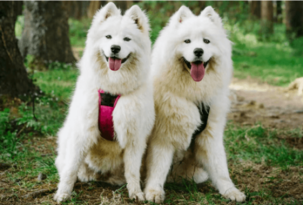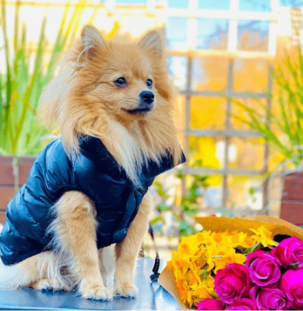Last Updated: 28/05/2025
Japanese Spitz Complete Breed Guide
Want to know if a Japanese Spitz is right for you? Take a look at our Vet-written guide for all the facts health and care tips.
Author: Dr Josepha Cox BBiomedSc (Hons) DVM
Reading Time: 5 minutes - short read
A complete breed guide for Japanese Spitz Dogs
Best known for their stunning, thick white coats, the Japanese Spitz is a happy, energetic and intelligent dog. They adore human company but also get along well with other dogs and pets.
Contents:
2. History
3. Personality
4. Best toys for Japanese Spitz
Japanese Spitz Facts
| Breed size: | Place of origin: | Intelligence |
| Small | Japan | High |
| Breed group: | Energy level: | Weight range: |
| Non-Sporting | Medium | 4-11kg |
| Life expectancy: | Tendency to bark: | Height range: |
| 12 - 16 years | Medum | 30-38cm |
| Drool factor: | Coat tyype: | Colours: |
| Low | Long double coat | White |
| Shedding factor: | Overall grooming needs: | Ease of Training: |
| Moderate to heavy | Moderate | Easy |
How big do Japanese Spitz get?Japanese Spitz are small breed dogs with an average height of 30-38 cm and weigh 4.5-11kg. Males are usually larger than females. |
Do Japanese Spitz shed?Overall Japanese Spitz will have a small amount of fur lost throughout the year so they need to be brushed at least once weekly. However, twice per year they undergo a full shed of their undercoat. A lot of fur will be lost during this time so daily brushing is required. |
How much does a Japanese Spitz cost?A purebred Japanese Spitz from a reputable breeder typically costs between $2500 - $4500. Japanese Spitz crosses or those from adoption agencies will likely be less. |
Are Japanese Spitzes good pets?Japanese Spitz are bred for companionship so make wonderful pets. They're typically good with children and other animals. As they love to be around people they're best suited to households that can provide them with a lot of attention. |
How long do Japanese Spitz live?Japanese Spitz are overall a healthy breed and can live between 12-16 years of age. As with any breed, they will live much longer if you feed them a premium quality diet, never let them become overweight, and keep their teeth in top condition! |
Do Japanese Spitz bark a lot?Japanese Spitz are a vigilant breed and so are moderate barkers. They make good guardians and will bark when alerted. |
How do I choose a Japanese Spitz breeder?It's always recommended to adopt from a shelter or rescue organisation where possible but otherwise finding a reputable breeder with their own breeder registration number is essential. Finding a breeder who is registered with the Australian National Kennel Club is a bonus as they put a lot of time and effort into ensuring they breed healthy and well adjusted puppies. A good breeder should always allow you to inspect their premises and meet the puppies' parents and will be happy to answer the 10 Breeder Checklist Questions. Good breeders socialise their animals and house them humanely. Read our Guide to Finding a Good Breeder for more tips. Buying from online forums or trading sites is generally not recommended. |
How much exercise do Japanese Spitz need?The Japanese Spitz is an energetic breed that needs about an hour of exercise per day. They love to run but are also happy to lounge out with their families as long as they've had their daily dose of activity. |
Japanese Spitz History

Photo credit: Yulia Strizhkina from Pexels.
The exact history of the Japanese Spitz remains unknown as the records were destroyed during world war II. It is thought they were originally bred from the German Spitz which was introduced to Japan in the 1920's. These were then bred with the Keeshond and White Spitz to create the breed standard that was recognized by the Japanese Kennel Club in 1948. By the 1950's the Japanese Spitz began being exported all over the world and became increasingly popular in North America, Europe and Australia.
Japanese Spitz Personality
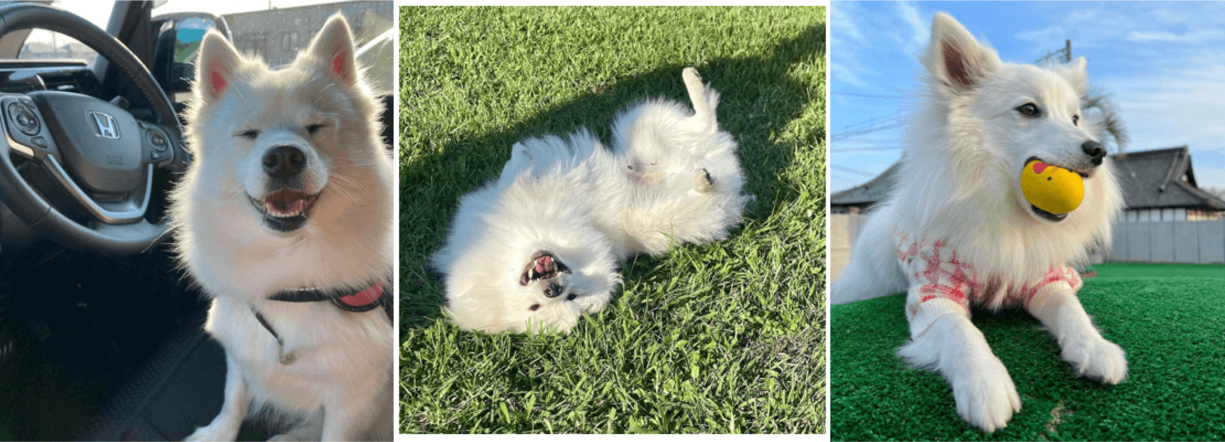
Photo credits from left: @noenoel.spitz, @uni_spitz, and @kinu_jpspitz
The Japanese Spitz is a fun loving and intelligent companion. As they love human attention they aim to please and are always happy to have a cuddle! They are energetic but also adaptable so they can live in an apartment as long as their daily exercise needs are met. They are loyal and easy to train but can develop behaviour issues if left alone for long periods of time.
Best toys for Japanese Spitz
This clever invention allows you to chuck your dog's favourite ball further than ever before, turning a simple game of fetch into a real workout. Its comfortable grip and integrated claw allow you to pick up your dogs ball without needing to bend down or touch any slobber

Safe for use in the water, easy to spot, soft and resilient frisbee.
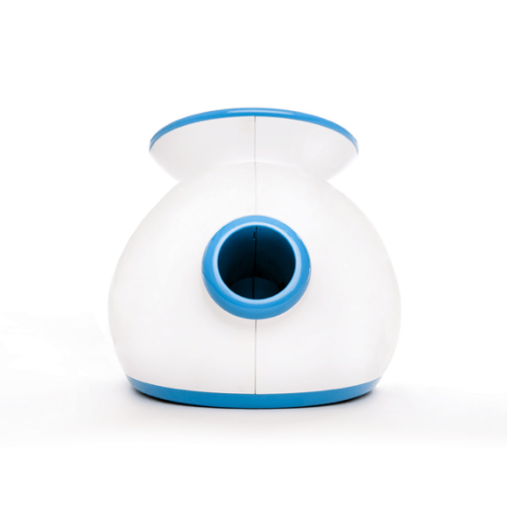
Award-winning automatic ball launcher. Great for the backyard on when your pooch is home alone.
This puzzle Feeder is a great way to teach your dog problem-solving skills and provide engagement whilst they eat. Also a great activity to keep them engaged when home alone.
Japanese Spitz Diet and Nutrition

Photo credit: Yulia Strizhkina from Pexels.
Japanese Spitz Puppies
Some points to note about Japanese Spitz puppy ownership include:
⢠Food: Japanese Spitz puppies should eat a premium, small breed formula such as Advance Small Puppy until they are 12 months of age.
⢠Behaviour: Japanese Spitz puppies have fantastic personalities but do like to chew and destroy things, just like any puppy! Puppy proofing your house is essential. Remove any easy-to-reach toxins or electrical cords, and provide plenty of toys! For more information on puppy behaviour, take a look at our Puppy Training Guide.
⢠Worming: Japanese Spitz puppies need to be wormed fortnightly from the age of 2-12 weeks and then once per month after this. In Australia, Japanese Spitz puppies also require heartworm protection. You may wish to get a heartworm injection yearly at your vet or you can simply give a monthly treatment such as Nexgard Spectra, Simparica Trio, or Credelio Plus.
For more helpful information on worming, training, socialisation, and nutrition, consult our veterinary-written Complete New Puppy Guide.
What To Feed A Japanese Spitz Puppy
Japanese Spitz puppies should eat a premium diet that is nutritionally formulated to meet AAFCO Guidelines until they are 12 months of age. You may consider a Rotation Diet to provide exposure to different proteins and reduce the risk of food sensitivities.
Raw diets for Japanese Spitz puppies carry the possibility of bacterial contamination which can be a zoonotic risk and upset their sensitive tummies. Plus, many raw or home made diets are unbalanced nutritionally and this can lead to deficiencies. To read more on how to raw feed safely or the pros and cons of raw diets check out our article: Raw Diets: The Risks and Benefits.
To find out whether your pup is ready to transition to an adult diet, take a look at our Body Condition Assessment Charts, or ask our Vet Squad for further advice.
Top food recommendations for Japanese Spitz Puppies
Formulated with highly digestible proteins and fibres to support optimal digestive health. Royal Canin Mini Puppy has an optimal energy content to support your small breed puppy through their growth period, as well as balanced calcium and phosphorus to promote healthy bone development.

This super premium dry puppy food is a complete and balanced diet for small breed puppies. This specialised blend is tailored to improve your puppy's health and wellbeing by promoting strong joints and a healthy immune system in your pet through enriching ingredients.
A high quality, Australian made natural diet especially formulated for small breed puppies. Made with Australian chicken, rich in essential amino acids for strong bone and muscle development, with rice and oats for sustained energy. With the addition of sweet potato, high in fibre to support good digestion.
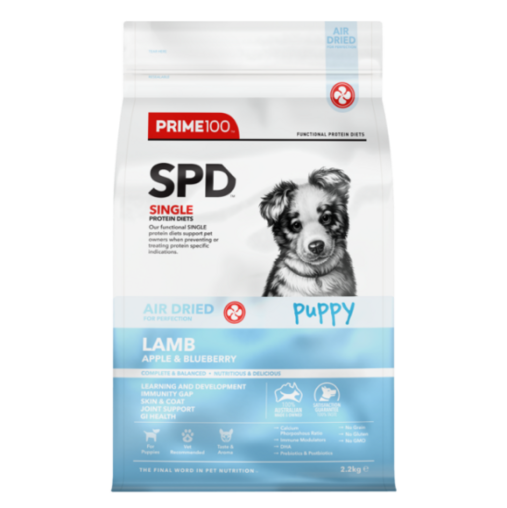
Air dried to lock in flavour and essential nutrients, this complete & balanced diet for puppies it is made with grass fed Australian Lamb, fruits and natural prebiotics & probiotics to promote a healthy microbiome in the gut. Targeted levels of protein, fat, antioxidants, and essential amino acids provide young growing dogs with the nutritional support they need.
Want to know more? Check out our article:Â What is the best puppy food?
Best Food for Adult Japanese Spitz
Although there are no specific feeding requirements for a Japanese Spitz, their diet needs to be age-appropriate and meet all of their daily nutritional and energy demands. Small Breed Adult or Puppy Food from premium brands including Hills Science Diet, Royal Canin, or Advance are suitable. These scientifically-formulated diets also contain balanced levels of protein, fat and carbohydrate plus vitamins, minerals and antioxidants for health and wellbeing.
This super premium, Australian-made, dry dog food is complete and balanced to support the nutritional requirements of adult toy and small breed dogs. This diet is highly palatable, containing tasty turkey and high quality ingredients to tempt fussy eaters.
This premium dry dog food is made from highly digestible ingredients to deliver optimally balanced nutrition. It is enriched with omega 3 and 6 fatty acids to support healthy skin and a shiny coat, and also contains nutrients to bind salivary calcium which helps to reduce dental tartar formation for good oral health.
Black Hawk Lamb & Rice is a high quality, Australian made, holistic diet for adult small breed dogs. It contains functional ingredients from nature like blueberries, dandelion and rosemary. With added food grade emu oil, Black Hawk Lamb & Rice is rich in omega fatty acids for healthy skin and a shiny, lustrous coat.
Air dried to lock in flavour and essential nutrients. A complete & balanced food made from Australian Chicken and Brown Rice. Chicken provides a species appropriate protein, glucosamine, calcium and essential amino acids, while brown rice contains natural fibre and antioxidants.
For more information, read through our guide to the Best Food for Small Dogs.
Japanese Spitz Health Problems
Japanese Spitz can be quite robust little dogs but they are prone to a few conditions including patella luxation, progressive retinal atrophy and dental disease.
Patella Luxation
Patellar luxation is a condition where the dog's kneecap slips out of its normal position and is often associated with skeletal deformities that are present at birth; however, some can occur due to trauma. The abnormal movement in the knee can cause pain, mobility issues and the development of arthritis. Severe cases require surgery while more mild cases can be supported with keeping your pooch at a healthy weight and the use of dog joint supplements. Further information can be found here.
Progressive retinal atrophy (PRA)
PRA is a disease where the retina (the structure in the eye that interprets light) gradually deteriorates and leads to vision loss. It is an inherited condition and has two main forms; early age onset where signs are often seen by 18 months of age and late age onset. Late age onset is usually more common. There is no treatment for PRA but testing can be done by breeders or on individual dogs to see if they have or are carriers of some of the common genes that cause PRA.
Dental issues
Small breed dogs like the Japanese Spitz are prone to dental disease. The buildup of tartar on teeth can cause gingivitis (inflammation of the gums), pain, infection and tooth loss. Japanese Spitz puppies can also suffer from retained puppy teeth which often need to be removed surgically. Starting an oral care routine early and regular dental checks is a great way to prevent dental disease in your pooch.
Find out more about preventing dental disease in our guide Dental Care for Dogs
Best supplements and products for the Japanese Spitz
You'll certainly need some help looking after those beautiful Japanese Spitz coats so the below products are perfect! The dental pack is also sure to be a hit to help keep on top of your pooches dental health.
A pH balanced and soap-free shampoo that is ideal for white and light coloured coats. Enriched with orange and grapefruit essential oils, this shampoo adds brilliance and shine to the coat without bleaching.
This self cleaning brush helps clean and remove mats, dander and trapped dirt.
Gently remove knots and add shine to your pets coat with the Tangle Remover. It repels dirt, adds shine and makes brushing more comfortable.

With dental disease being a common issue in Japanese Spitz this variety dental pack is sure to have something your pooch enjoys that's also beneficial for their teeth!
Related Breeds to the Japanese Spitz
The Japanese Spitz is classified in the 'Spitz' breed group - this group consists of dogs bred to live in cold northern climates. The Spitz family is very large and includes sled dogs such as Huskies and Malamutes, herding dogs such as the Samoyed, Finnish Lapphund, Asian breeds such as the Shiba Inu, Japanese Spitz, Chow Chow, Shar Pei, and Akita, and companion dogs such as the Danish Spitz, the Keeshond, and the Pomeranian.

Keeshond
Belonging to the sporting group of dogs this is one of the original breeds thought to have contributed to the creation of the Japanese Spitz.
German Spitz
One of the most ancient breeds in Europe. Belonging to the utility dog group they are thought to have also played a role in the origin of the Japanese Spitz.
Samoyed
The Samoyed is a medium-sized Spitz breed originating from Russia. It tends to grow to be 16-27kg in weight and 46-56cm in height. They are very fluffy and sport a thick, white double coat and a curled tail, just like many spitz breeds.
The Pomeranian
Considered the smaller cousin to the Japanese Spitz, the Pomeranian and Japanese Spitz share the fluffy, thick coat, although Pomeranian's come in a range of colours while Japanese Spitz are only white.
Further Reading
Want to know more? Check out our Discover Page for more tips from our expert vets on keeping your pets happy and healthy.
Sources:
1. https://www.akc.org/dog-breeds/japanese-spitz/
2. https://bowwowinsurance.com.au/dogs/dog-breeds/japanese-spitz/
3. https://www.purina.com.au/dogs/breeds/japanese-spitz

